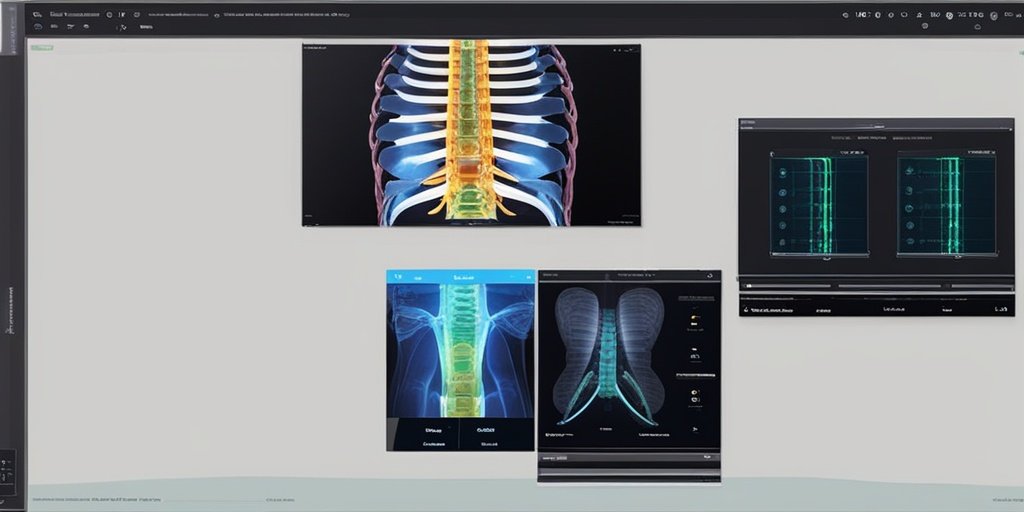⚡ Quick Summary
A recent study developed a deep learning-based cascaded HRNet model to automatically measure X-ray imaging parameters of lumbar sagittal curvature, achieving a remarkable 97.9-100% accuracy in key-point detection. This model demonstrates significant potential for enhancing clinical applications in spinal assessments.
🔍 Key Details
- 📊 Dataset: 3730 lumbar lateral digital radiography images
- 🧩 Features used: Landmarks for lumbar curvature parameters
- ⚙️ Technology: Deep learning-based cascaded HRNet model
- 🏆 Performance: PCK of 97.9-100%, ICC of 0.989-0.999
🔑 Key Takeaways
- 📊 Automatic measurement of lumbar sagittal curvature parameters is now feasible.
- 💡 Deep learning enhances the accuracy of X-ray imaging assessments.
- 👩🔬 Strong correlation between automated and manual measurements (ICC = 0.989-0.999).
- 🏆 Mean absolute errors were minimal across various parameters (0.01 mm to 1.11°).
- 🌍 Clinical significance in improving diagnostic efficiency and accuracy.
- 📈 Potential for integration into routine clinical practice for spinal assessments.
- 🔍 Study conducted using a comprehensive dataset from PACS.

📚 Background
Accurate measurement of lumbar sagittal curvature is crucial for diagnosing and treating spinal disorders. Traditional methods often rely on manual measurements, which can be time-consuming and subject to human error. The advent of deep learning technologies offers a promising solution to automate and enhance the precision of these measurements, potentially transforming clinical practices in orthopedics and radiology.
🗒️ Study
The study involved the development of a cascaded HRNet model to automatically identify and measure key landmarks related to lumbar curvature from a dataset of 3730 X-ray images. The researchers meticulously marked the lumbar curve index (LCI), lumbar lordosis angle (LLA), sacral slope (SS), lumbar lordosis index (LLI), and the posterior edge tangent angle (PTA) to evaluate the model’s performance against manual measurements.
📈 Results
The cascaded HRNet model demonstrated exceptional performance, with a percentage of correct key-points (PCK) ranging from 97.9% to 100% within a 3 mm distance threshold. The mean differences between the model’s predictions and manual measurements were minimal, indicating a high level of accuracy and reliability in the model’s outputs. The strong correlation coefficients (ICC and Pearson) further validate the model’s effectiveness.
🌍 Impact and Implications
The implications of this study are profound. By automating the measurement of lumbar sagittal curvature parameters, the cascaded HRNet model could significantly reduce the time required for assessments and improve diagnostic accuracy. This advancement not only enhances patient care but also streamlines workflows in clinical settings, paving the way for broader applications of AI in medical imaging.
🔮 Conclusion
This study highlights the transformative potential of deep learning algorithms in the field of medical imaging. The successful implementation of the cascaded HRNet model for automatic measurement of lumbar curvature parameters marks a significant step forward in clinical practice. Continued research and development in this area could lead to even more sophisticated tools that enhance diagnostic capabilities and improve patient outcomes.
💬 Your comments
What are your thoughts on the integration of AI in medical imaging? Do you believe it will revolutionize the way we approach spinal assessments? 💬 Share your insights in the comments below or connect with us on social media:
Performance evaluation of a deep learning-based cascaded HRNet model for automatic measurement of X-ray imaging parameters of lumbar sagittal curvature.
Abstract
PURPOSE: To develop a deep learning-based cascaded HRNet model, in order to automatically measure X-ray imaging parameters of lumbar sagittal curvature and to evaluate its prediction performance.
METHODS: A total of 3730 lumbar lateral digital radiography (DR) images were collected from picture archiving and communication system (PACS). Among them, 3150 images were randomly selected as the training dataset and validation dataset, and 580 images as the test dataset. The landmarks of the lumbar curve index (LCI), lumbar lordosis angle (LLA), sacral slope (SS), lumbar lordosis index (LLI), and the posterior edge tangent angle of the vertebral body (PTA) were identified and marked. The measured results of landmarks on the test dataset were compared with the mean values of manual measurement as the reference standard. Percentage of correct key-points (PCK), intra-class correlation coefficient (ICC), Pearson correlation coefficient (r), mean absolute error (MAE), mean square error (MSE), root-mean-square error (RMSE), and Bland-Altman plot were used to evaluate the performance of the cascade HRNet model.
RESULTS: The PCK of the cascaded HRNet model was 97.9-100% in the 3 mm distance threshold. The mean differences between the reference standard and the predicted values for LCI, LLA, SS, LLI, and PTA were 0.43 mm, 0.99°, 1.11°, 0.01 mm, and 0.23°, respectively. There were strong correlation and consistency of the five parameters between the cascaded HRNet model and manual measurements (ICC = 0.989-0.999, R = 0.991-0.999, MAE = 0.63-1.65, MSE = 0.61-4.06, RMSE = 0.78-2.01).
CONCLUSION: The cascaded HRNet model based on deep learning algorithm could accurately identify the sagittal curvature-related landmarks on lateral lumbar DR images and automatically measure the relevant parameters, which is of great significance in clinical application.
Author: [‘Wu Y’, ‘Chen X’, ‘Dong F’, ‘He L’, ‘Cheng G’, ‘Zheng Y’, ‘Ma C’, ‘Yao H’, ‘Zhou S’]
Journal: Eur Spine J
Citation: Wu Y, et al. Performance evaluation of a deep learning-based cascaded HRNet model for automatic measurement of X-ray imaging parameters of lumbar sagittal curvature. Performance evaluation of a deep learning-based cascaded HRNet model for automatic measurement of X-ray imaging parameters of lumbar sagittal curvature. 2024; 33:4104-4118. doi: 10.1007/s00586-023-07937-5